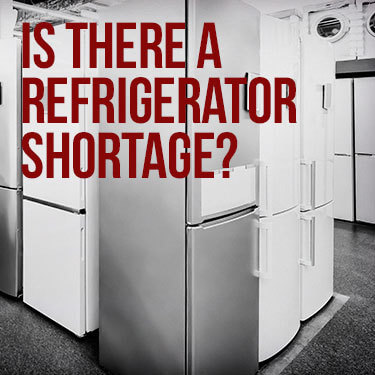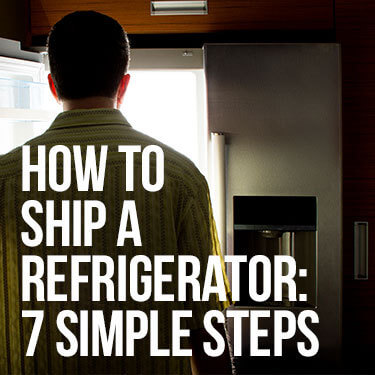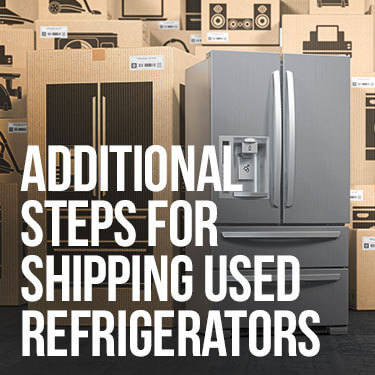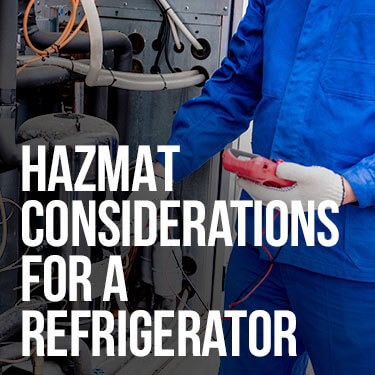Understanding how to ship a refrigerator is important information to know if you want to make sure it still works after arriving. Owners of appliance stores, appliance distributors and even the average person moving to a new home will need to know how to transport their fridge correctly. Refrigerators must be shipped with absolute care and in strict accordance with applicable regulations.
The Department of Transportation (DOT) has standards in place for shipping refrigerators that follow current HAZMAT guidelines. Shippers check for these standards before preparing a refrigerator for shipment. A refrigerator needs to have its shelves removed, doors secured, and a to be placed in a fitted box packing material.
These are the basics on how to ship a refrigerator, but we’ll explain each part in detail so you’ll know exactly how to get your refrigerator to its destination safely.

There isn’t just a refrigerator shortage, there’s an entire shortage for home appliances as well. One of the primary reasons for the shortage of home appliances like refrigerators is the COVID-19 pandemic. The pandemic caused many appliance factories to shut down which stopped the production of these machines.
Despite the fact that the pandemic has created a shortage, the demand by consumers for refrigerators and other appliances has gone up. In fact, it estimated that refrigerator sales are only going to rise the next three years
| 2023 | $223.77 |
| 2024 | $230.79 |
| 2025 | $236.92 |
When shipping a refrigerator, you’ll need to adhere to shipping guidelines to prevent any damage from occurring. You’ll also want to correctly ship your fridge if you’re a store owner who ships appliances to customers. Any damage the refrigerator sustains will likely result in an angry customer wanting their money back.
HVAC units are also an important home essential. Our article on HAVAC transportation will show you how to get this type of equipment to your home.

To ship a refrigerator you’ll have to follow several different steps. However, none of the steps that you’ll have to complete are too difficult.
Before you can start preparing your refrigerator for shipment, you’re going to need some of the following shipping supplies:
Once you have these shipping materials ready, you can start getting your refrigerator ready for pickup.
Begin shipping prep work on your refrigerator by measuring its dimensions. Taking measurements of your fridge will help you discern how big of a box you will need for it. The measurements can also tell you how much and how large the packing material will need to be when you wrap the exterior of the fridge which is a later step we’ll discuss.
The second step to ship a refrigerator is to remove the shelves and drawers from within it. Although the refrigerator will be secure within the confines of its box, the shelves within will move slightly out of place while the refrigerator is in transit.
The subtle movements that the shelves and drawers will absorb could cause them to sustain damage.
To avoid this unwanted damage, follow these four steps:
Shipping the shelves separately from the rest of the refrigerator will ensure that they stay protected.
Once you have the drawers out of the way, you can move on to securing the doors. Most refrigerator doors do a good job at staying shut. That said, there’s always the possibility that they could swing open during transport.
Therefore, you need to tape the doors of your fridge shut using painter's tape or gaffer tape. The good thing about these types of tape is that they won’t leave any type of residue behind on the fridge. You’ll also need to make sure that you apply multiple pieces of tape along the length of the refrigerator doors.
Refrigerators have delicate surfaces that need to be protected while they’re being transported. Keeping the exterior wrapped will allow for some extra protection if the refrigerator tips over or is handled carelessly while being loaded and unloaded. Using the measurements you took in the first step, get the right amount of packing material for your fridge.
There are a variety of different packing materials that you can use to wrap your refrigerator such as:
Either of these materials will work fine, but we strongly suggest using shipping blankets, as they will offer the most amount of protection for your refrigerator. Our article on blanket wrap shipping will give you more information about the benefits of this packing material.
Using the measurements you took of your refrigerator in step one, find a fitted box for your refrigerator to go inside. If there is an exceptional amount of space between the box and the refrigerator, you’ll need to fill it with some more packing materials to make sure the refrigerator is as secure as possible.
Now that the fridge is snugly secured inside its box, you will need to secure your refrigerator to a pallet. To do this, simply obtain some straps and have the straps run down the length of the refrigerator and underneath the pallet. You will also need to have at least two straps running horizontally across the refrigerator.
Using a pallet is essential when transporting heavy appliances like refrigerators because of how heavy they are. It’s much easier to load and unload a palletized refrigerator with a forklift rather than lifting it by hand.
Finally, you will need to include the correct labels on the outside of the refrigerator’s box and the box or boxes holding the shelves and drawers of your refrigerator.
Some of the labels that you will need include:
The international shipping label will only be needed if you’re going to send your refrigerator to another country. All of these labels help communicate important information that will allow the carrier to handle your refrigerator with care and transport its destination successfully.

Shipping a used refrigerator is pretty similar to shipping a new refrigerator as far as what steps you’ll need to follow. The only difference is that you’ll have to complete two preliminary steps beyond the ones we’ve already listed.
The first step of shipping a used refrigerator will be to clean the inside of it. Fridges will inevitably get dirty, even if you make sure to keep them clean while they’re in use. If you don’t clean the inside of your fridge very often, now would be a great time to do so since you’ll be taking all the food and drinks out of it anyways.
Cleaning the inside of the fridge is an especially good idea if you’re shipping it to someone who bought it from you. The last thing a new owner wants is a smelly fridge. There are many ways you can give your refrigerator a fresh and clean smell.
Some of those options include:
Using any of these options will give your refrigerator a fresh scent. You can even ship your refrigerator with baking soda or charcoal inside of it.
A fridge that is in use will need to be disconnected and defrosted before you undertake any further preparation.
To complete this process, just follow these quick steps:
If you find these steps challenging in any way, you can always hire a handyperson to help you out. Once you disconnect and defrost the fridge, you can measure it and follow through with the rest of the steps we listed before

Shippers and consumers alike don’t usually associate hazardous materials with refrigerators. However, refrigerators are considered hazardous goods because they contain at least some hazardous chemicals.
These include substances such as:
These toxic materials can cause serious medical issues for anyone who comes into contact with them. Since refrigerators are considered hazmat, you will need to follow all of the applicable hazmat shipping regulations.
The hazmat regulations that DOT enforces comes from Title 49 of the Code Of Federal Regulations. These regulations dictate that shippers are responsible for:
Three key pieces of information that you will need to include throughout responsibilities one through four are the UN ID number, the proper shipping name, and the hazard class/division for your refrigerator. These pieces of information will have to be listed somewhere on those four materials.
There are two UN ID numbers for refrigerators which are:
Next, you will need to list the correct shipping name for your refrigerator. All products that have UN ID numbers have a proper shipping name to go along with them. For refrigerators, the correct shipping name is “refrigerating machine.”
The final piece of information that you will need to disclose is the class of hazardous materials that your refrigerator belongs under. There are nine total hazmat classes.
For a refrigerator you will use either:
Or
Class 2.1 will apply to refrigerators classified by UN ID 3358 and class 2.2 will be used. For more information about hazardous goods, look into our article on freight shipping hazardous materials.
White glove service delivery is essentially when a shipping company not only delivers an appliance to its destination but also installs the appliance for the customer receiving it.
This is an excellent service to provide if you wish that will make shipping easier, but it is by no means mandatory. You can learn more about this service from our white glove delivery guide
R+L Global Logistics partners with numerous carriers across the country that can ship just about any type of freight, including appliances like refrigerators. Not only that, but we can also provide white glove delivery services for appliance shipments.
While it’s rare that your refrigerator will get damaged on its journey to a customer, there’s always that chance something can go wrong. At R+L Global Logistics, we offer affordable freight insurance that will give you coverage if an accident does occur.
To discover more about our appliance shipping and freight insurance, give us a call at 866-353-7178 or fill out your quote today!
R+L Global Logistics
315 NE 14th St., Ocala, FL 34470